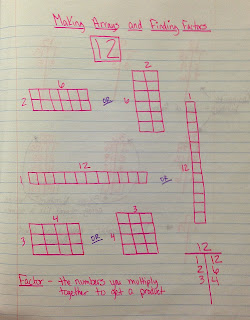We begin our lesson on finding the factors of a number by making all the arrays we can think of for the number 12. The kids usually do a really good job finding them all. When I question if we've found them all, however, the kids start to second-guess themselves. This moves us into the discussion of what we're actually finding when we're making these arrays. I lead them to discover they're finding the factors (number that are multiplied to make a number) of 12.
But how can we keep our factors organized so we can make sure we've found all the factors? This leads us to making our T-Chart. We always start with 1 and the number itself. Then we move to the next number in the number line, 2. We know 2 is a factor because 12 is even, so we then find the partner for 2 which is 6. Then we move to 3, which has a partner of 4. The next number in the number line is 4, which we've already used, so we know we're done. Once numbers start to repeat, we've found all our factors. This lesson is followed by lots of practice finding the factors of many different numbers. As we're making our factor lists, we discuss the definition of prime, composite, and square numbers.



No comments:
Post a Comment